FDMG-1105 Menu Planning and Purchasing Project: Restaurant Design
VerifiedAdded on 2023/01/18
|10
|1626
|27
Project
AI Summary
This project outlines the development of a new family-style Middle Eastern restaurant in Toronto, Canada. The assignment details the restaurant's concept, emphasizing a fusion of traditional and contemporary flavors with a focus on fresh, homemade ingredients and a 'go green' décor. The target customers are families and groups, with an emphasis on health-conscious millennials. The menu features popular Middle Eastern dishes such as kebabs, shawarma, and falafel, with detailed specifications for ingredients and equipment. The project includes an inventory list, product specification sheets, and vendor sourcing summary forms, with an emphasis on quality, ethical sourcing, and daily supply. The restaurant's menu design, layout, and overall concept are also detailed, providing a comprehensive plan for a successful restaurant launch.
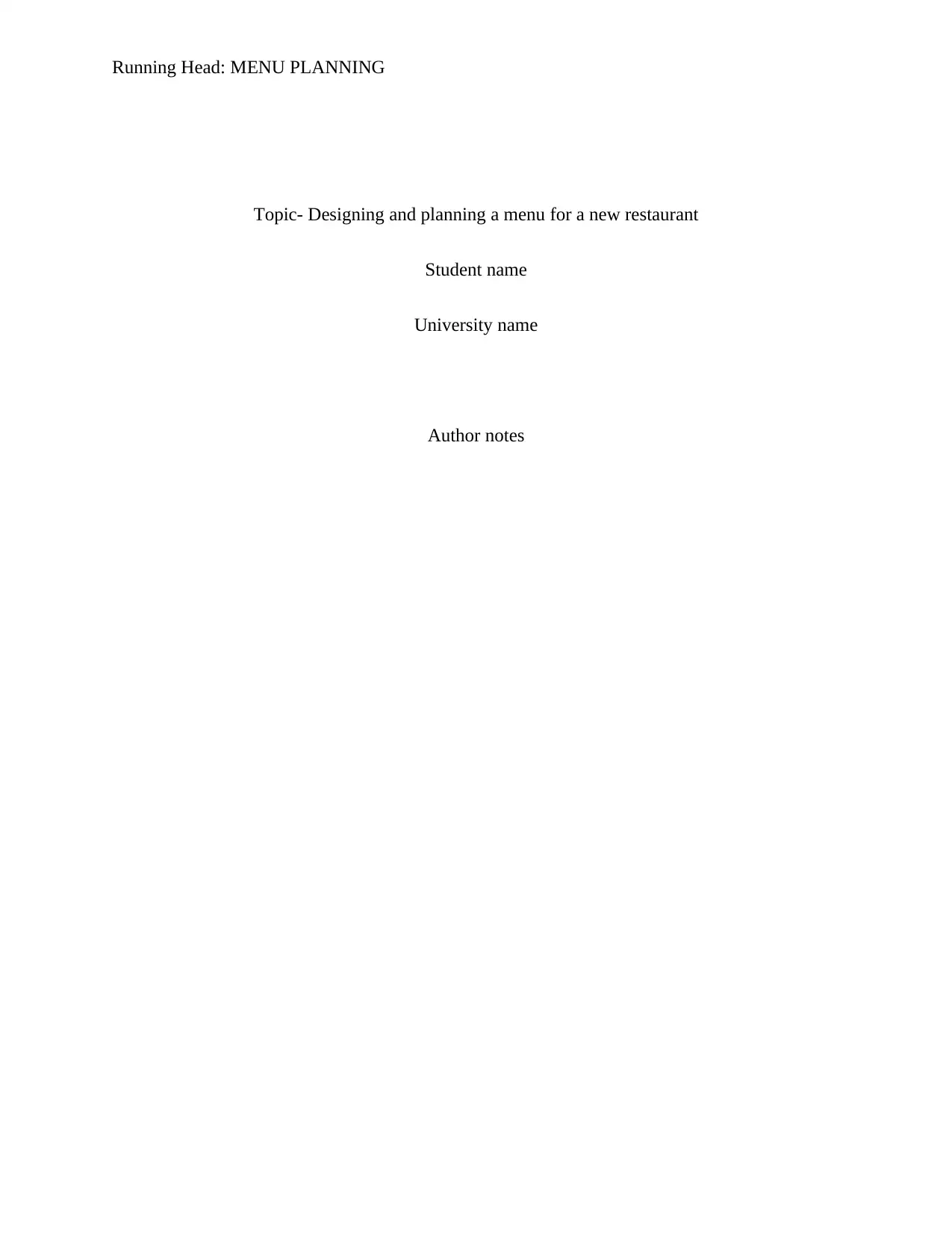
Running Head: MENU PLANNING
Topic- Designing and planning a menu for a new restaurant
Student name
University name
Author notes
Topic- Designing and planning a menu for a new restaurant
Student name
University name
Author notes
Paraphrase This Document
Need a fresh take? Get an instant paraphrase of this document with our AI Paraphraser
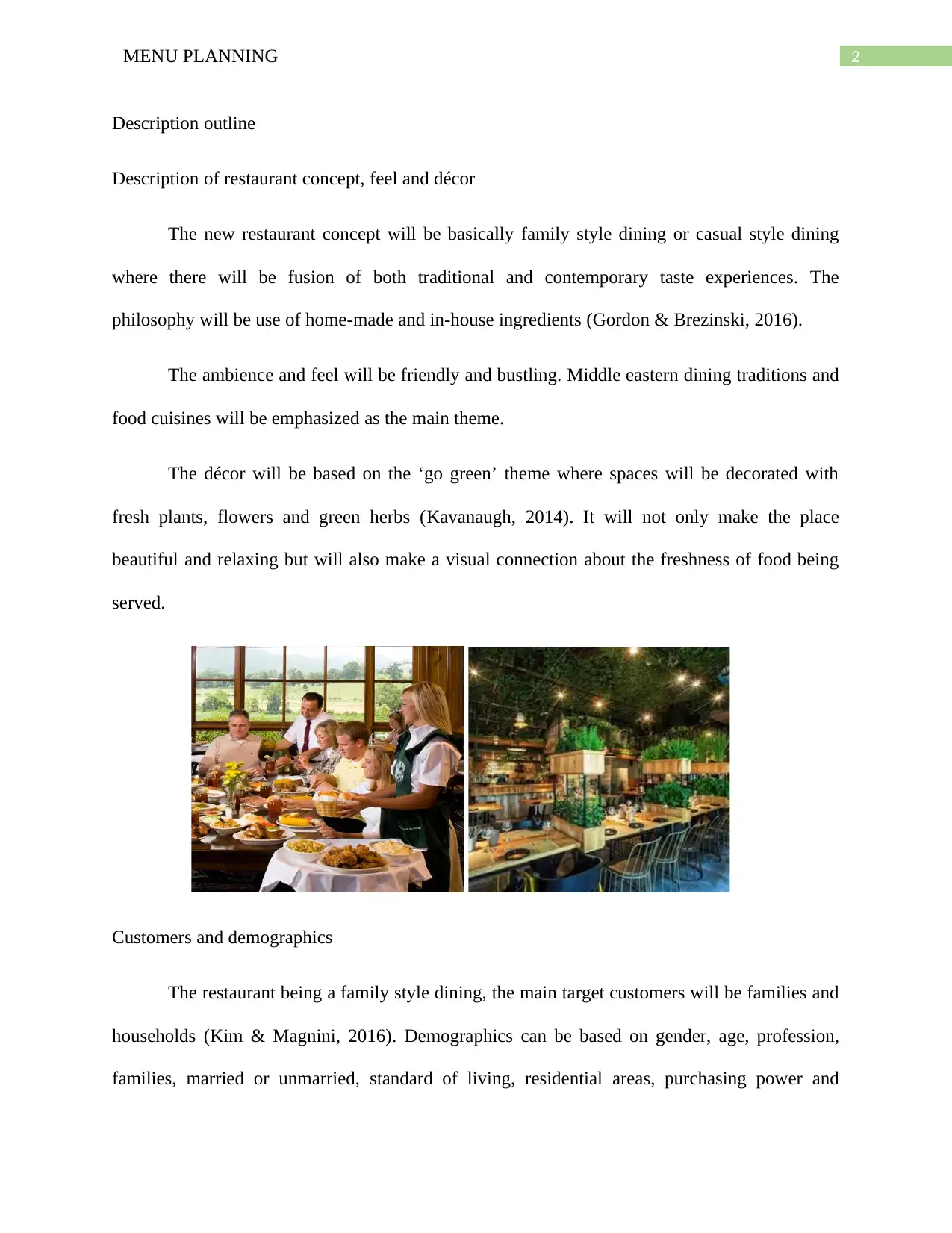
2MENU PLANNING
Description outline
Description of restaurant concept, feel and décor
The new restaurant concept will be basically family style dining or casual style dining
where there will be fusion of both traditional and contemporary taste experiences. The
philosophy will be use of home-made and in-house ingredients (Gordon & Brezinski, 2016).
The ambience and feel will be friendly and bustling. Middle eastern dining traditions and
food cuisines will be emphasized as the main theme.
The décor will be based on the ‘go green’ theme where spaces will be decorated with
fresh plants, flowers and green herbs (Kavanaugh, 2014). It will not only make the place
beautiful and relaxing but will also make a visual connection about the freshness of food being
served.
Customers and demographics
The restaurant being a family style dining, the main target customers will be families and
households (Kim & Magnini, 2016). Demographics can be based on gender, age, profession,
families, married or unmarried, standard of living, residential areas, purchasing power and
Description outline
Description of restaurant concept, feel and décor
The new restaurant concept will be basically family style dining or casual style dining
where there will be fusion of both traditional and contemporary taste experiences. The
philosophy will be use of home-made and in-house ingredients (Gordon & Brezinski, 2016).
The ambience and feel will be friendly and bustling. Middle eastern dining traditions and
food cuisines will be emphasized as the main theme.
The décor will be based on the ‘go green’ theme where spaces will be decorated with
fresh plants, flowers and green herbs (Kavanaugh, 2014). It will not only make the place
beautiful and relaxing but will also make a visual connection about the freshness of food being
served.
Customers and demographics
The restaurant being a family style dining, the main target customers will be families and
households (Kim & Magnini, 2016). Demographics can be based on gender, age, profession,
families, married or unmarried, standard of living, residential areas, purchasing power and
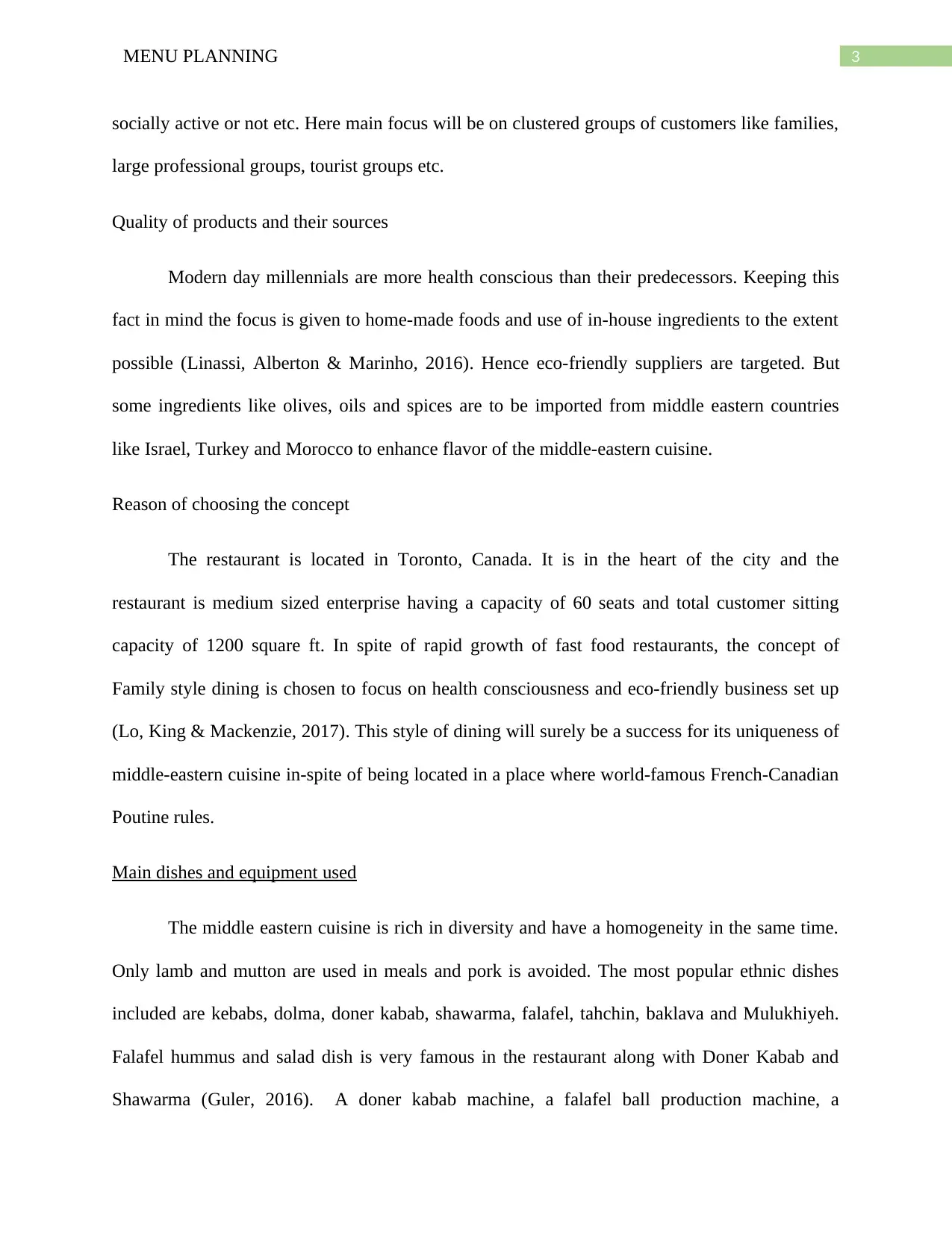
3MENU PLANNING
socially active or not etc. Here main focus will be on clustered groups of customers like families,
large professional groups, tourist groups etc.
Quality of products and their sources
Modern day millennials are more health conscious than their predecessors. Keeping this
fact in mind the focus is given to home-made foods and use of in-house ingredients to the extent
possible (Linassi, Alberton & Marinho, 2016). Hence eco-friendly suppliers are targeted. But
some ingredients like olives, oils and spices are to be imported from middle eastern countries
like Israel, Turkey and Morocco to enhance flavor of the middle-eastern cuisine.
Reason of choosing the concept
The restaurant is located in Toronto, Canada. It is in the heart of the city and the
restaurant is medium sized enterprise having a capacity of 60 seats and total customer sitting
capacity of 1200 square ft. In spite of rapid growth of fast food restaurants, the concept of
Family style dining is chosen to focus on health consciousness and eco-friendly business set up
(Lo, King & Mackenzie, 2017). This style of dining will surely be a success for its uniqueness of
middle-eastern cuisine in-spite of being located in a place where world-famous French-Canadian
Poutine rules.
Main dishes and equipment used
The middle eastern cuisine is rich in diversity and have a homogeneity in the same time.
Only lamb and mutton are used in meals and pork is avoided. The most popular ethnic dishes
included are kebabs, dolma, doner kabab, shawarma, falafel, tahchin, baklava and Mulukhiyeh.
Falafel hummus and salad dish is very famous in the restaurant along with Doner Kabab and
Shawarma (Guler, 2016). A doner kabab machine, a falafel ball production machine, a
socially active or not etc. Here main focus will be on clustered groups of customers like families,
large professional groups, tourist groups etc.
Quality of products and their sources
Modern day millennials are more health conscious than their predecessors. Keeping this
fact in mind the focus is given to home-made foods and use of in-house ingredients to the extent
possible (Linassi, Alberton & Marinho, 2016). Hence eco-friendly suppliers are targeted. But
some ingredients like olives, oils and spices are to be imported from middle eastern countries
like Israel, Turkey and Morocco to enhance flavor of the middle-eastern cuisine.
Reason of choosing the concept
The restaurant is located in Toronto, Canada. It is in the heart of the city and the
restaurant is medium sized enterprise having a capacity of 60 seats and total customer sitting
capacity of 1200 square ft. In spite of rapid growth of fast food restaurants, the concept of
Family style dining is chosen to focus on health consciousness and eco-friendly business set up
(Lo, King & Mackenzie, 2017). This style of dining will surely be a success for its uniqueness of
middle-eastern cuisine in-spite of being located in a place where world-famous French-Canadian
Poutine rules.
Main dishes and equipment used
The middle eastern cuisine is rich in diversity and have a homogeneity in the same time.
Only lamb and mutton are used in meals and pork is avoided. The most popular ethnic dishes
included are kebabs, dolma, doner kabab, shawarma, falafel, tahchin, baklava and Mulukhiyeh.
Falafel hummus and salad dish is very famous in the restaurant along with Doner Kabab and
Shawarma (Guler, 2016). A doner kabab machine, a falafel ball production machine, a
⊘ This is a preview!⊘
Do you want full access?
Subscribe today to unlock all pages.

Trusted by 1+ million students worldwide
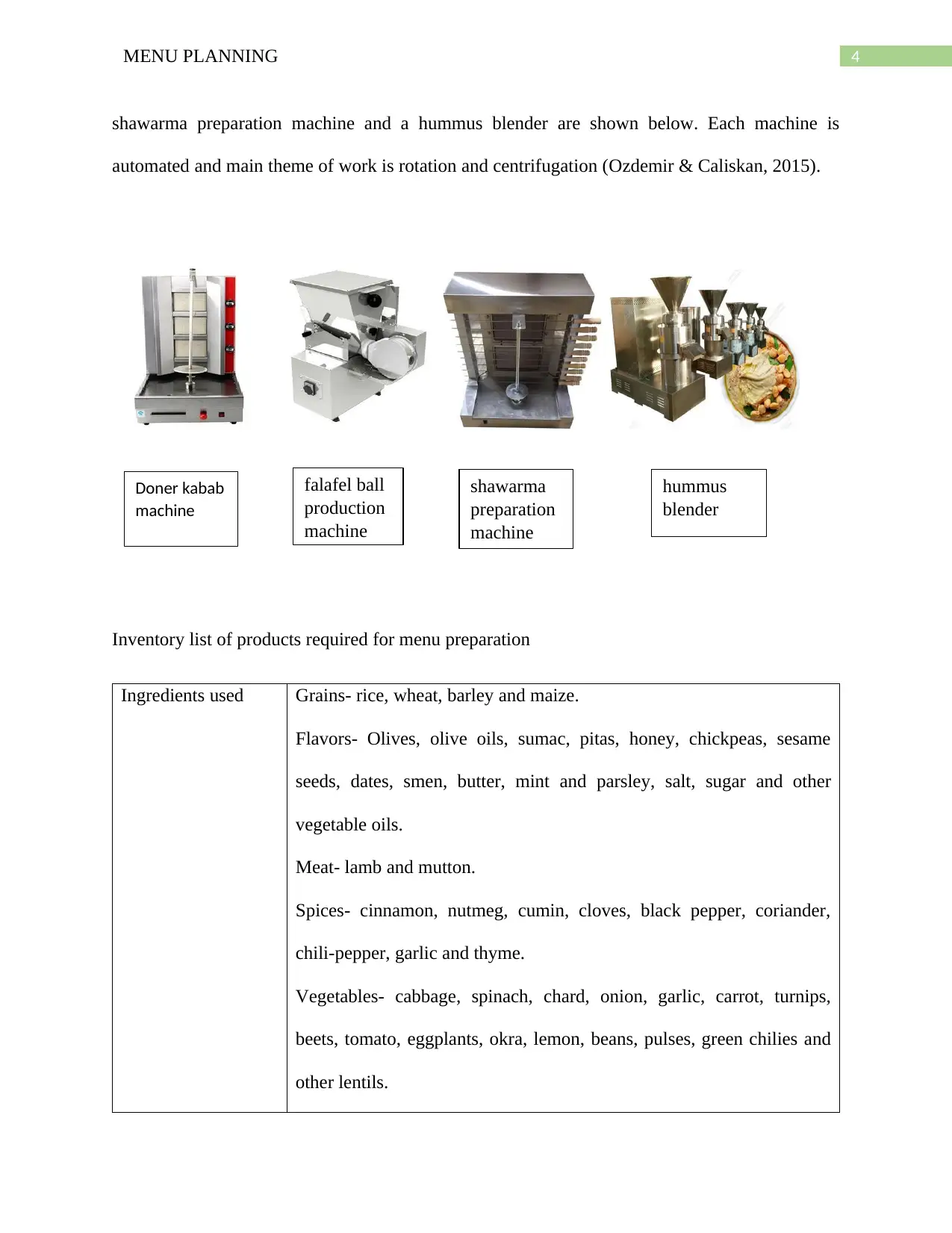
4MENU PLANNING
shawarma preparation machine and a hummus blender are shown below. Each machine is
automated and main theme of work is rotation and centrifugation (Ozdemir & Caliskan, 2015).
Inventory list of products required for menu preparation
Ingredients used Grains- rice, wheat, barley and maize.
Flavors- Olives, olive oils, sumac, pitas, honey, chickpeas, sesame
seeds, dates, smen, butter, mint and parsley, salt, sugar and other
vegetable oils.
Meat- lamb and mutton.
Spices- cinnamon, nutmeg, cumin, cloves, black pepper, coriander,
chili-pepper, garlic and thyme.
Vegetables- cabbage, spinach, chard, onion, garlic, carrot, turnips,
beets, tomato, eggplants, okra, lemon, beans, pulses, green chilies and
other lentils.
Doner kabab
machine
falafel ball
production
machine
shawarma
preparation
machine
hummus
blender
shawarma preparation machine and a hummus blender are shown below. Each machine is
automated and main theme of work is rotation and centrifugation (Ozdemir & Caliskan, 2015).
Inventory list of products required for menu preparation
Ingredients used Grains- rice, wheat, barley and maize.
Flavors- Olives, olive oils, sumac, pitas, honey, chickpeas, sesame
seeds, dates, smen, butter, mint and parsley, salt, sugar and other
vegetable oils.
Meat- lamb and mutton.
Spices- cinnamon, nutmeg, cumin, cloves, black pepper, coriander,
chili-pepper, garlic and thyme.
Vegetables- cabbage, spinach, chard, onion, garlic, carrot, turnips,
beets, tomato, eggplants, okra, lemon, beans, pulses, green chilies and
other lentils.
Doner kabab
machine
falafel ball
production
machine
shawarma
preparation
machine
hummus
blender
Paraphrase This Document
Need a fresh take? Get an instant paraphrase of this document with our AI Paraphraser
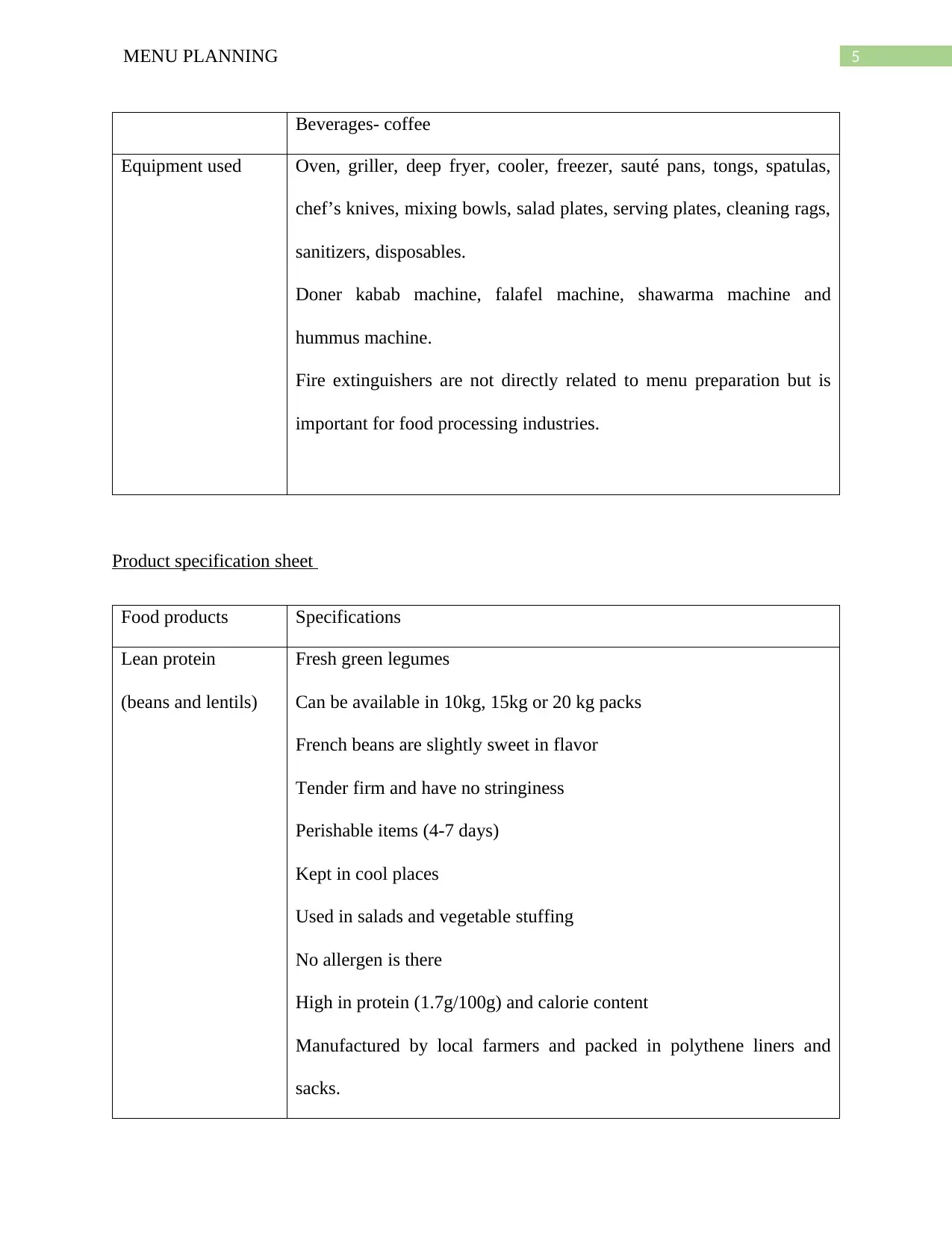
5MENU PLANNING
Beverages- coffee
Equipment used Oven, griller, deep fryer, cooler, freezer, sauté pans, tongs, spatulas,
chef’s knives, mixing bowls, salad plates, serving plates, cleaning rags,
sanitizers, disposables.
Doner kabab machine, falafel machine, shawarma machine and
hummus machine.
Fire extinguishers are not directly related to menu preparation but is
important for food processing industries.
Product specification sheet
Food products Specifications
Lean protein
(beans and lentils)
Fresh green legumes
Can be available in 10kg, 15kg or 20 kg packs
French beans are slightly sweet in flavor
Tender firm and have no stringiness
Perishable items (4-7 days)
Kept in cool places
Used in salads and vegetable stuffing
No allergen is there
High in protein (1.7g/100g) and calorie content
Manufactured by local farmers and packed in polythene liners and
sacks.
Beverages- coffee
Equipment used Oven, griller, deep fryer, cooler, freezer, sauté pans, tongs, spatulas,
chef’s knives, mixing bowls, salad plates, serving plates, cleaning rags,
sanitizers, disposables.
Doner kabab machine, falafel machine, shawarma machine and
hummus machine.
Fire extinguishers are not directly related to menu preparation but is
important for food processing industries.
Product specification sheet
Food products Specifications
Lean protein
(beans and lentils)
Fresh green legumes
Can be available in 10kg, 15kg or 20 kg packs
French beans are slightly sweet in flavor
Tender firm and have no stringiness
Perishable items (4-7 days)
Kept in cool places
Used in salads and vegetable stuffing
No allergen is there
High in protein (1.7g/100g) and calorie content
Manufactured by local farmers and packed in polythene liners and
sacks.
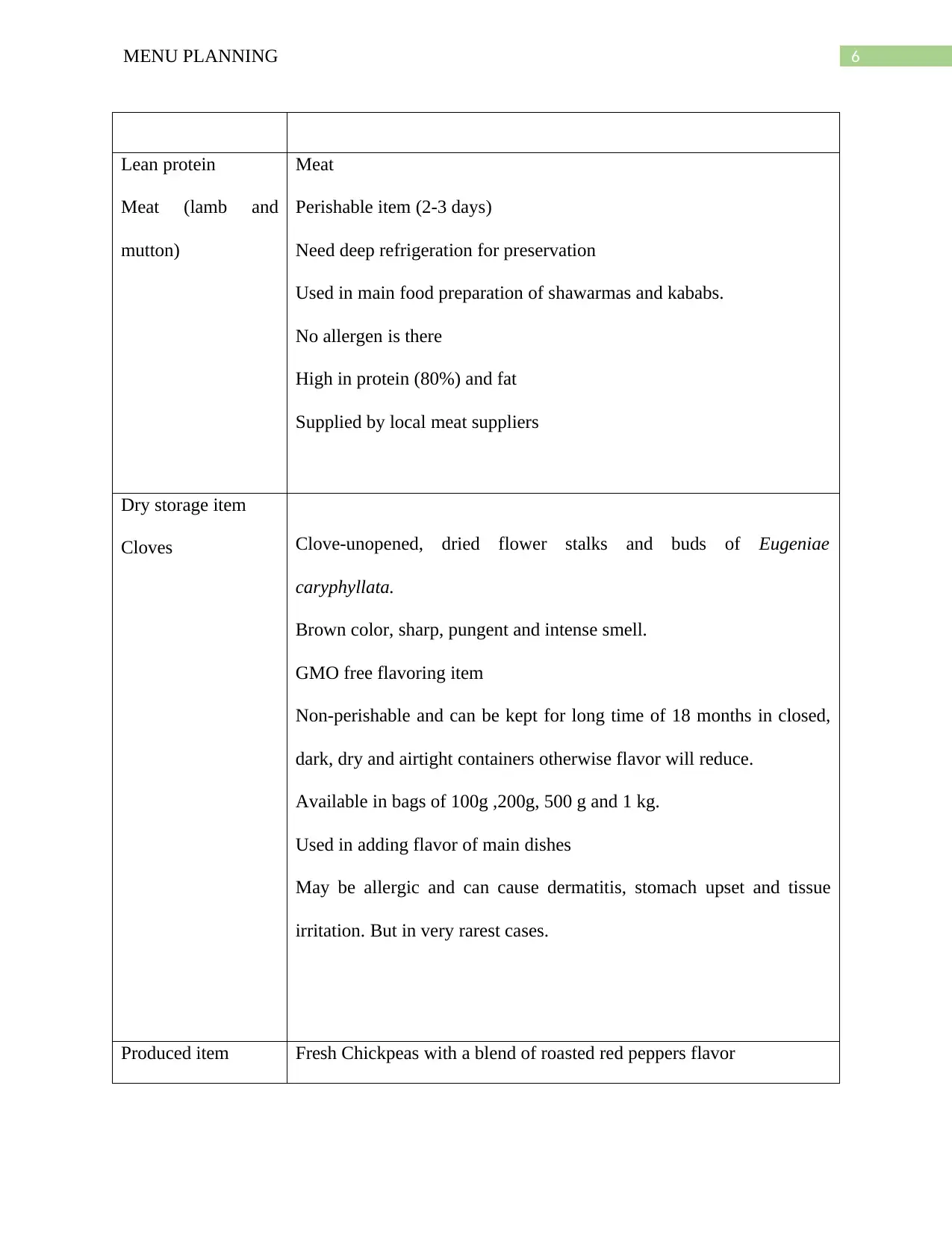
6MENU PLANNING
Lean protein
Meat (lamb and
mutton)
Meat
Perishable item (2-3 days)
Need deep refrigeration for preservation
Used in main food preparation of shawarmas and kababs.
No allergen is there
High in protein (80%) and fat
Supplied by local meat suppliers
Dry storage item
Cloves Clove-unopened, dried flower stalks and buds of Eugeniae
caryphyllata.
Brown color, sharp, pungent and intense smell.
GMO free flavoring item
Non-perishable and can be kept for long time of 18 months in closed,
dark, dry and airtight containers otherwise flavor will reduce.
Available in bags of 100g ,200g, 500 g and 1 kg.
Used in adding flavor of main dishes
May be allergic and can cause dermatitis, stomach upset and tissue
irritation. But in very rarest cases.
Produced item Fresh Chickpeas with a blend of roasted red peppers flavor
Lean protein
Meat (lamb and
mutton)
Meat
Perishable item (2-3 days)
Need deep refrigeration for preservation
Used in main food preparation of shawarmas and kababs.
No allergen is there
High in protein (80%) and fat
Supplied by local meat suppliers
Dry storage item
Cloves Clove-unopened, dried flower stalks and buds of Eugeniae
caryphyllata.
Brown color, sharp, pungent and intense smell.
GMO free flavoring item
Non-perishable and can be kept for long time of 18 months in closed,
dark, dry and airtight containers otherwise flavor will reduce.
Available in bags of 100g ,200g, 500 g and 1 kg.
Used in adding flavor of main dishes
May be allergic and can cause dermatitis, stomach upset and tissue
irritation. But in very rarest cases.
Produced item Fresh Chickpeas with a blend of roasted red peppers flavor
⊘ This is a preview!⊘
Do you want full access?
Subscribe today to unlock all pages.

Trusted by 1+ million students worldwide
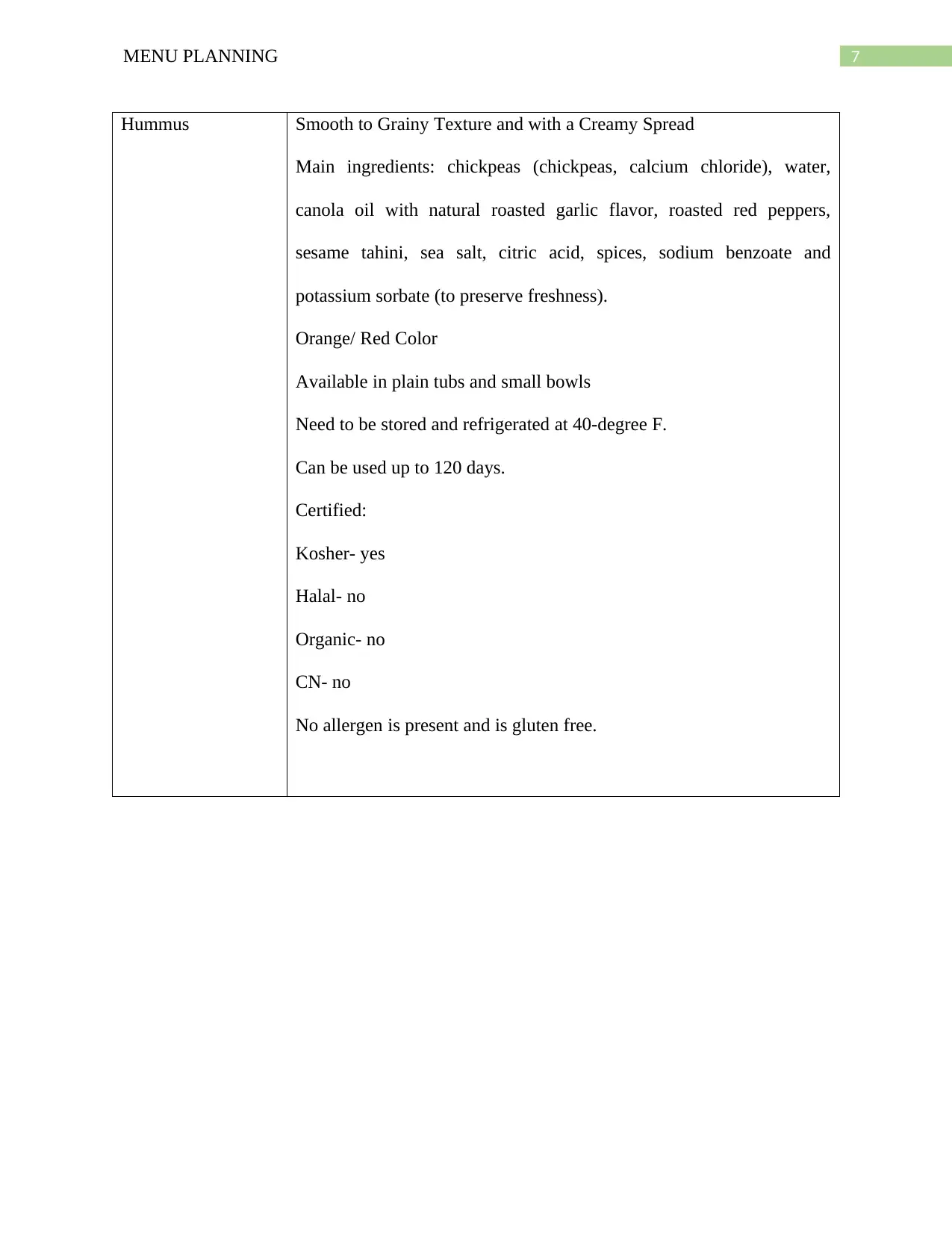
7MENU PLANNING
Hummus Smooth to Grainy Texture and with a Creamy Spread
Main ingredients: chickpeas (chickpeas, calcium chloride), water,
canola oil with natural roasted garlic flavor, roasted red peppers,
sesame tahini, sea salt, citric acid, spices, sodium benzoate and
potassium sorbate (to preserve freshness).
Orange/ Red Color
Available in plain tubs and small bowls
Need to be stored and refrigerated at 40-degree F.
Can be used up to 120 days.
Certified:
Kosher- yes
Halal- no
Organic- no
CN- no
No allergen is present and is gluten free.
Hummus Smooth to Grainy Texture and with a Creamy Spread
Main ingredients: chickpeas (chickpeas, calcium chloride), water,
canola oil with natural roasted garlic flavor, roasted red peppers,
sesame tahini, sea salt, citric acid, spices, sodium benzoate and
potassium sorbate (to preserve freshness).
Orange/ Red Color
Available in plain tubs and small bowls
Need to be stored and refrigerated at 40-degree F.
Can be used up to 120 days.
Certified:
Kosher- yes
Halal- no
Organic- no
CN- no
No allergen is present and is gluten free.
Paraphrase This Document
Need a fresh take? Get an instant paraphrase of this document with our AI Paraphraser
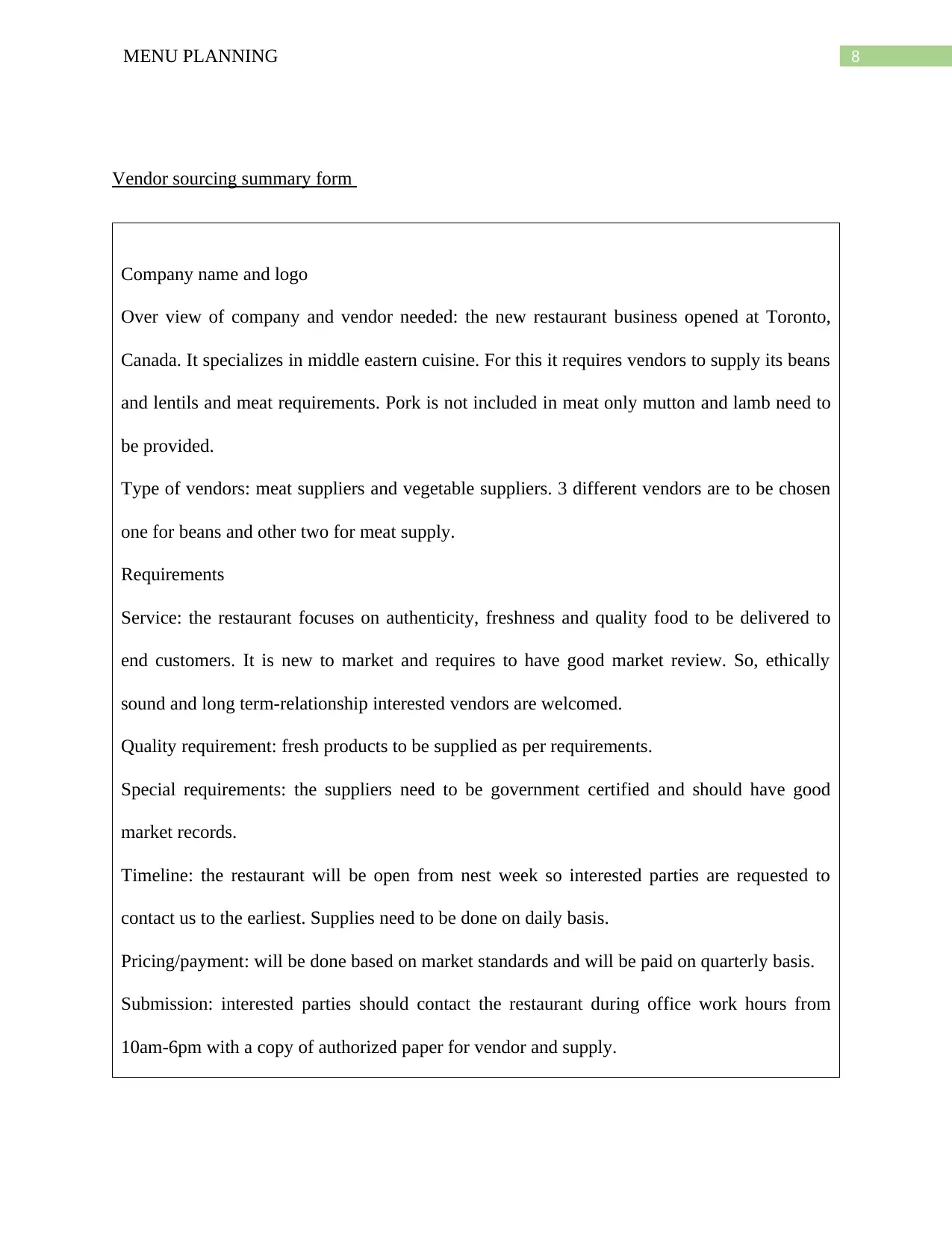
8MENU PLANNING
Vendor sourcing summary form
Company name and logo
Over view of company and vendor needed: the new restaurant business opened at Toronto,
Canada. It specializes in middle eastern cuisine. For this it requires vendors to supply its beans
and lentils and meat requirements. Pork is not included in meat only mutton and lamb need to
be provided.
Type of vendors: meat suppliers and vegetable suppliers. 3 different vendors are to be chosen
one for beans and other two for meat supply.
Requirements
Service: the restaurant focuses on authenticity, freshness and quality food to be delivered to
end customers. It is new to market and requires to have good market review. So, ethically
sound and long term-relationship interested vendors are welcomed.
Quality requirement: fresh products to be supplied as per requirements.
Special requirements: the suppliers need to be government certified and should have good
market records.
Timeline: the restaurant will be open from nest week so interested parties are requested to
contact us to the earliest. Supplies need to be done on daily basis.
Pricing/payment: will be done based on market standards and will be paid on quarterly basis.
Submission: interested parties should contact the restaurant during office work hours from
10am-6pm with a copy of authorized paper for vendor and supply.
Vendor sourcing summary form
Company name and logo
Over view of company and vendor needed: the new restaurant business opened at Toronto,
Canada. It specializes in middle eastern cuisine. For this it requires vendors to supply its beans
and lentils and meat requirements. Pork is not included in meat only mutton and lamb need to
be provided.
Type of vendors: meat suppliers and vegetable suppliers. 3 different vendors are to be chosen
one for beans and other two for meat supply.
Requirements
Service: the restaurant focuses on authenticity, freshness and quality food to be delivered to
end customers. It is new to market and requires to have good market review. So, ethically
sound and long term-relationship interested vendors are welcomed.
Quality requirement: fresh products to be supplied as per requirements.
Special requirements: the suppliers need to be government certified and should have good
market records.
Timeline: the restaurant will be open from nest week so interested parties are requested to
contact us to the earliest. Supplies need to be done on daily basis.
Pricing/payment: will be done based on market standards and will be paid on quarterly basis.
Submission: interested parties should contact the restaurant during office work hours from
10am-6pm with a copy of authorized paper for vendor and supply.
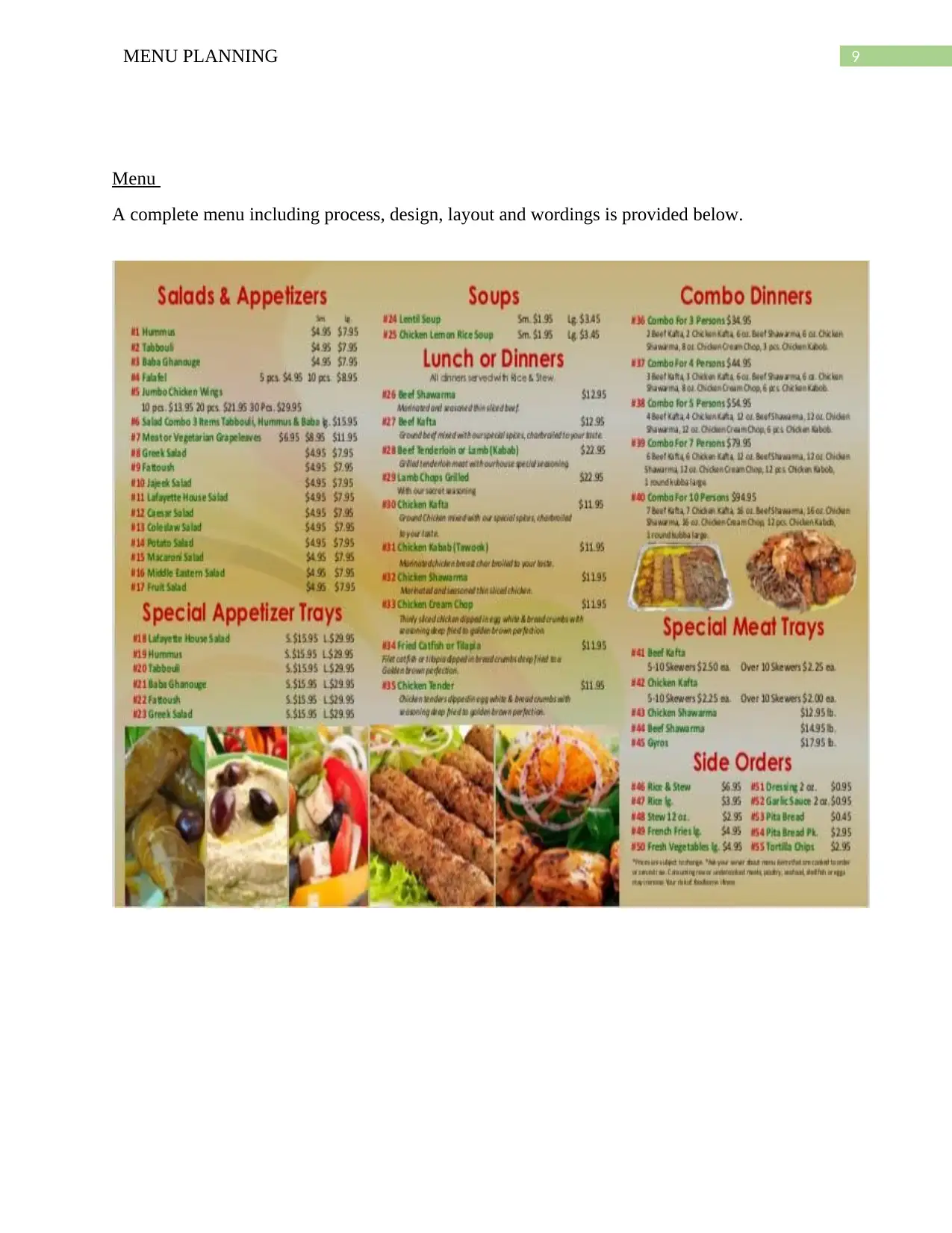
9MENU PLANNING
Menu
A complete menu including process, design, layout and wordings is provided below.
Menu
A complete menu including process, design, layout and wordings is provided below.
⊘ This is a preview!⊘
Do you want full access?
Subscribe today to unlock all pages.

Trusted by 1+ million students worldwide
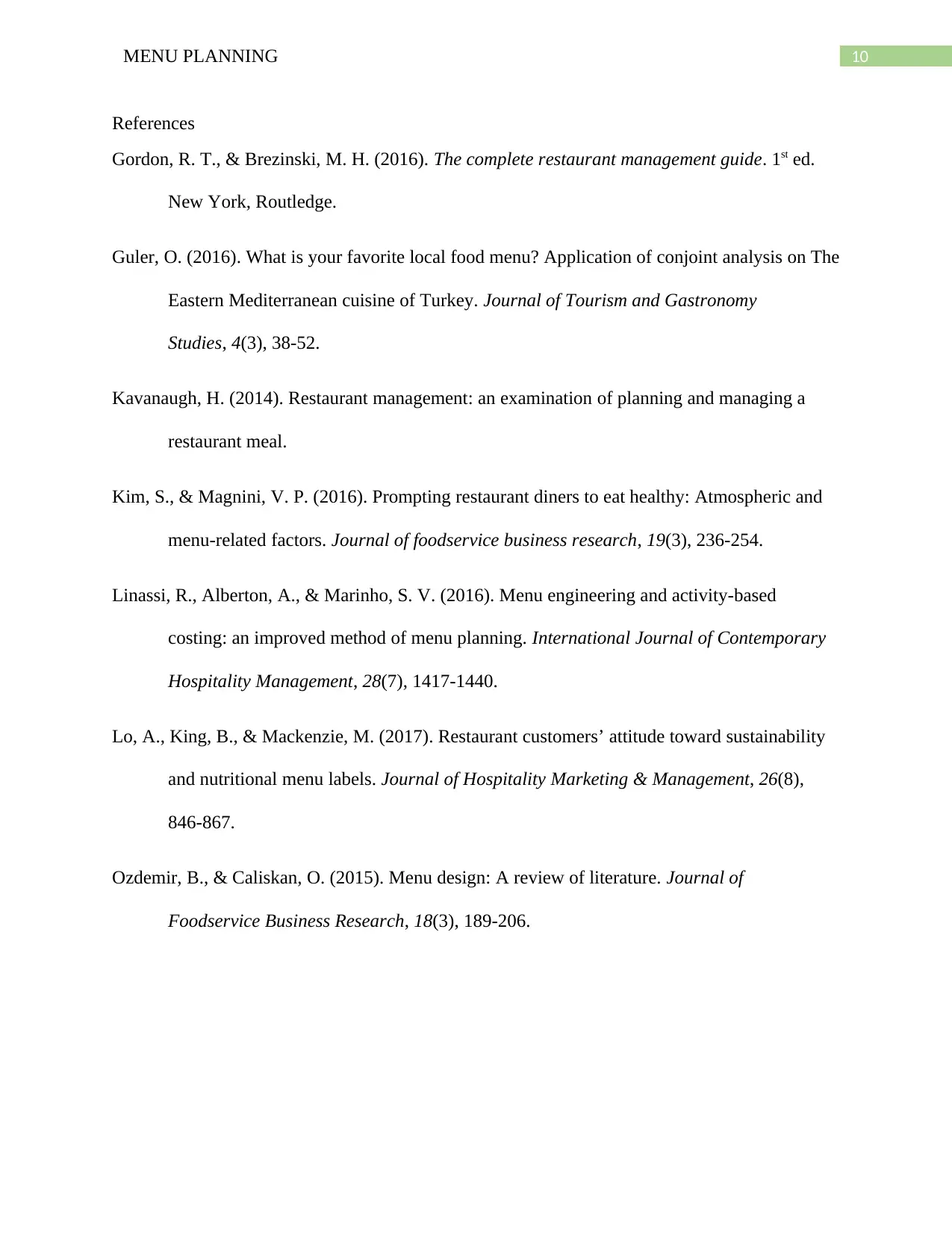
10MENU PLANNING
References
Gordon, R. T., & Brezinski, M. H. (2016). The complete restaurant management guide. 1st ed.
New York, Routledge.
Guler, O. (2016). What is your favorite local food menu? Application of conjoint analysis on The
Eastern Mediterranean cuisine of Turkey. Journal of Tourism and Gastronomy
Studies, 4(3), 38-52.
Kavanaugh, H. (2014). Restaurant management: an examination of planning and managing a
restaurant meal.
Kim, S., & Magnini, V. P. (2016). Prompting restaurant diners to eat healthy: Atmospheric and
menu-related factors. Journal of foodservice business research, 19(3), 236-254.
Linassi, R., Alberton, A., & Marinho, S. V. (2016). Menu engineering and activity-based
costing: an improved method of menu planning. International Journal of Contemporary
Hospitality Management, 28(7), 1417-1440.
Lo, A., King, B., & Mackenzie, M. (2017). Restaurant customers’ attitude toward sustainability
and nutritional menu labels. Journal of Hospitality Marketing & Management, 26(8),
846-867.
Ozdemir, B., & Caliskan, O. (2015). Menu design: A review of literature. Journal of
Foodservice Business Research, 18(3), 189-206.
References
Gordon, R. T., & Brezinski, M. H. (2016). The complete restaurant management guide. 1st ed.
New York, Routledge.
Guler, O. (2016). What is your favorite local food menu? Application of conjoint analysis on The
Eastern Mediterranean cuisine of Turkey. Journal of Tourism and Gastronomy
Studies, 4(3), 38-52.
Kavanaugh, H. (2014). Restaurant management: an examination of planning and managing a
restaurant meal.
Kim, S., & Magnini, V. P. (2016). Prompting restaurant diners to eat healthy: Atmospheric and
menu-related factors. Journal of foodservice business research, 19(3), 236-254.
Linassi, R., Alberton, A., & Marinho, S. V. (2016). Menu engineering and activity-based
costing: an improved method of menu planning. International Journal of Contemporary
Hospitality Management, 28(7), 1417-1440.
Lo, A., King, B., & Mackenzie, M. (2017). Restaurant customers’ attitude toward sustainability
and nutritional menu labels. Journal of Hospitality Marketing & Management, 26(8),
846-867.
Ozdemir, B., & Caliskan, O. (2015). Menu design: A review of literature. Journal of
Foodservice Business Research, 18(3), 189-206.
1 out of 10
Your All-in-One AI-Powered Toolkit for Academic Success.
+13062052269
info@desklib.com
Available 24*7 on WhatsApp / Email
![[object Object]](/_next/static/media/star-bottom.7253800d.svg)
Unlock your academic potential
Copyright © 2020–2025 A2Z Services. All Rights Reserved. Developed and managed by ZUCOL.


